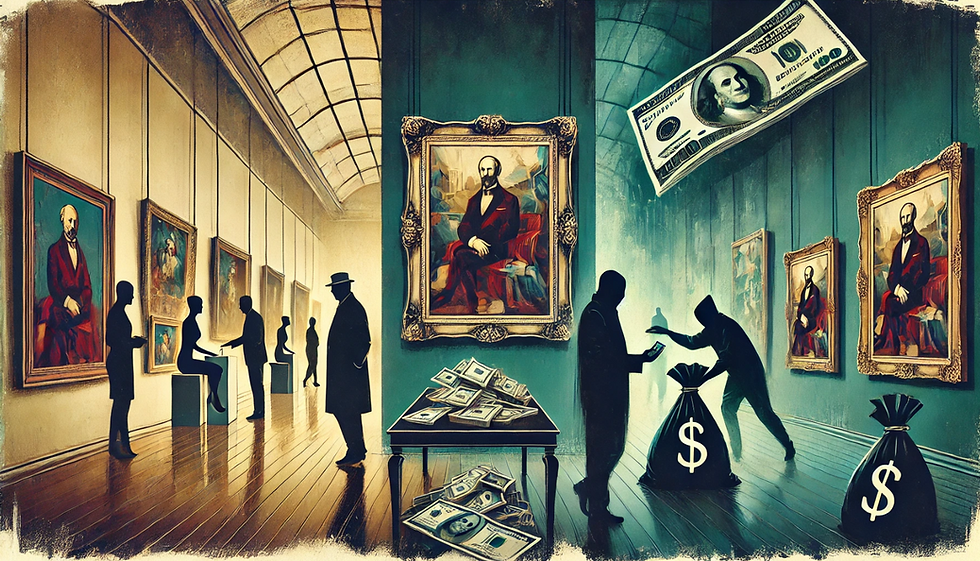Is art a means of money laundering?
- jonathan-pradillon

- Sep 10, 2024
- 3 min read

Because of its opaque and subjective nature, the art market is sometimes used as a tool to launder money. This illegal activity consists of concealing the origin of funds acquired by criminal means by integrating them into apparently legitimate transactions. Art, particularly works of great value, can become an ideal vehicle for such operations. The lack of strict regulation and the possibility of selling anything as a 'work of art' amplify these risks.
How Money Laundering Works in Art
Money laundering via art often relies on the ability to manipulate the price of works, the anonymity of buyers and sellers, and the use of international transactions. Here are some of the most common methods:
Buying and selling at inflated prices
A work of art can be bought for a relatively modest sum and then resold at an artificially inflated price to an accomplice or via an auction house. This mechanism makes it possible to launder money under the pretext of fluctuations in value.
Exchange of works of art between countries
Art, unlike cash, can be easily transported across borders, often without raising suspicion. This allows assets to be transferred from one country to another, where they can be sold legally, laundered in the process.
Use of works as guarantees or collateral
Ill-intentioned individuals can use works of art to obtain bank loans or financing. If the value of the work is inflated, the borrowed money can then be laundered when the work is sold or used for future transactions.
Art donations overvalued
By donating a work of art to a museum or gallery for an inflated amount, some people can not only launder money, but also benefit from tax deductions. This scheme relies on the subjective estimation of a work's value, which can be manipulated to serve illegitimate interests.
Art: a particularly vulnerable market
Unlike conventional goods, the perceived value of art is highly subjective. This means that anyone can declare an object, even one with little aesthetic or artistic value, to be a "work of art", often without any real appraisal to justify the price. This lack of regulation and transparency allows individuals to sell any object as a high-value item, making the art market particularly vulnerable to money laundering.
What's more, transactions on the art market can often take place anonymously. In many private sales or auctions, the identity of the buyer and seller is not systematically revealed. This anonymity facilitates the circulation of money from illicit sources, without any rigorous verification of the origin of the funds. Galleries and auction houses do not always have the same verification obligations as other financial sectors.
NFTs: a new money laundering opportunity?
NFTs (Non-Fungible Tokens), digital works of art authenticated by blockchain, have opened a new chapter in contemporary art. Although this technology is revolutionary, it has also attracted attention as a potential means of money laundering. NFT transactions are often anonymous, and purchase prices can appear arbitrary. This makes it easy for someone to create an NFT, sell it to an accomplice for an exorbitant amount, and then claim that the funds are of legitimate origin. Moreover, regulation of NFTs remains limited, creating additional opportunities for illicit activities.
Efforts to counter money laundering in art
Faced with this vulnerability, the authorities are trying to tighten regulations. In 2020, the European Union included the art market in its anti-money laundering directive, requiring players in the sector to verify the identity of buyers and sellers for transactions over €10,000. Some countries, such as the United States, are considering adopting similar laws.
Auction houses and galleries are also being encouraged to establish Know Your Customer (KYC) procedures to better monitor transactions and guarantee the legal origin of funds used to purchase works of art.
Art can easily become a tool for money laundering, due to its subjectivity, opacity and the ease with which prices can be inflated. The lack of regulation and the fact that virtually anything can be sold as a "work of art" amplifies this phenomenon. However, with increased legislative efforts to regulate the art market and the introduction of tighter controls, it is possible that the use of this sector for illicit activities will be curbed in the future. But until transparency and regulation are fully implemented, the art market will remain a potential target for money laundering activities.




Comments